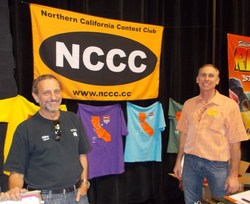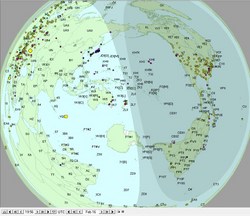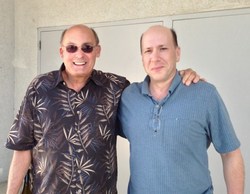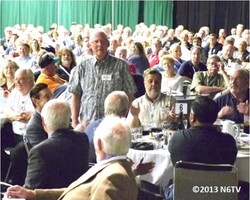 April 24, 2013 Editor: Ward Silver, NØAX | ||||||||
IN THIS ISSUE
NEW HF OPERATORS - THINGS TO DO Here's a thought - did you know that the ARRL offers a Code Proficiency Certificate? True! Copy some text at gradually-increasing speeds to get a series of endorsement stickers to the basic award. They go as high as 40 wpm! The next W1AW Qualifying Run is on May 7th and a West Coast run is on May 16th. Do a few CW contests, sharpen up that #2 pencil, and - are you QRV? BULLETINS No bulletin, but here's an assignment - tell your friends and club members about the free Contest Update newsletter and how to get it by using the Edit Your Profile link on the ARRL home page! BUSTED QSOS The PVRC newsletter for April was not yet available at the time of the last issue - it is available online now. (Thanks, Dennis ZS4BS) The New York QSO Party Coordinator is Brent KC2QLJ, not Bruce. (Thanks, Duane K2SI) CONTEST SUMMARY Complete information for all contests follows the Conversation section April 27-28
May 4-5
Let's be honest - you always wanted to wear a "zebra shirt" and blow a whistle - here's your chance! WRTC2014 is now accepting applications for referees. Unique in all of radiosport in that it places an on-site referee with every operating team, WRTC needs qualified contesters to keep an eye and an ear on the proceedings. "With the rules allowing both operators to transmit simultaneously the challenge for each referee is greater than ever," says Dan Street, K1TO, manager of the Team and Referee Selection Committee. The application period lasts until Dec 1st - check out the referee requirements on the WRTC2014 website.
Rovers and mobile station aficionados of state QSO parties should check out Chuck NO5W's CQ/X logging software that integrates directly with a GPS to keep track of your county and grid as your move around. Another issue unique to the state QSO parties and county-hunter contests is operating from a county line. New versions of N1MM software (version 13.04.01 and later) support several variations on the rules for operating astraddle jurisdictional boundaries, as well. (Thanks, Chuck NO5W and Craig K9CT) RTTY contesters take note - Larry K8UT is preparing a presentation for the Dayton Hamvention "RTTY Contesting Forum" in which he'd like to report opinions about the new RTTY decoder 2Tone's strengths and weaknesses. He has prepared a very short survey for both users, and non-users, of 2Tone RTTY software. Take a minute and add your perspective. It's only about a month until Saturday night at Dayton's Crowne Plaza where you can test your CW pileup skills on the latest competition concocted by Russ KØVXU for the Kansas City DX Club's hospitality suite. Chuck NO5W is the author of the superb "horse-race" viewer that keeps score and lets those in the suite cheer on the contestants as the test progresses. This year he's added a practice program to let you warm up a little bit before the contest by choosing audio files from previous years and seeing how you do. Let the trash-talking begin! The high-performance VHF/UHF antenna designs produced by Directive Systems (originally C3I) have a new owner. Terry W8ZN has purchased that product line and will be introducing some new 6 meter antennas in the near future. The new company was open for business as of April 1st. (Thanks, Chris W3CMP)
The new Radio-sport.net seems to be off and running with lots of new stories and features. This would be a good contesting website to keep in your bookmark list. Last week we lost a couple of contest veterans from opposite sides of the globe as Al VE1AL and Mike VK6HD both died on the same day. A frequent competitor in contests and in DX pileups from Halifax, Nova Scotia, Al was a competitive force from the Maritimes. Nearly at Al's antipode, Mike was a favorite source of Zone 29 QSOs for your editor and many others, including Top Band contacts over great distances to the Americas and Europe. Both will be sorely missed. This coming Saturday, April 27th, is Morse Code Day! Samuel Morse was born in 1791 and his invention of a telegraph and an effective coding method for text created the first "on line" medium, truly changing the world. The special event station W2M will operate from Locust Grove, Morse's villa, from 1400Z to 1900Z. (Thanks, Paul WØRW) Pete N4ZR checks in to say, "Thank you to everyone who offered to help with the World Contest Station Database. In response to my recent e-mail seeking a new home for it, I'm delighted to report that Bruce, WA7BNM has offered to incorporate the database into the offerings of his enhanced 3830 score reporting website. The move will be made in several weeks." An announcement from the Northern California DX Foundation (NCDXF) at the recent International DX Convention in Visalia, CA bodes well for bringing younger DXers and contesters into our hobby. NCDXF Director, Glenn K6NA announced, "NCDXF will provide full tuition scholarships for hams 25 years of age and younger at all DX University and Contest University sessions held in North America for the next year. This includes those held at the Dayton Hamvention next month." Thanks, NCDXF! For those of you geographers out there (and what contester isn't at heart a geography nut?) take a gander at this interesting online puzzle. Drag the shapes around the map and watch the Mercator distortion change them - they look so...so...familiar! Place the shapes on their actual location to complete the puzzle. (Thanks, Randy K5ZD)
Web Site of the Week - Speaking of maps, Rick ZL2HAM has created ViewProp a terrific new mapping program that takes a stream of spots or Reverse Beacon Network reports and plots them on any of a collection of maps from DX Atlas. Not only are the receiving stations displayed but the path between them, with color indicating the band and variable persistence, among other interesting options. It's fascinating to see the different bands opening and closing as the Earth rotates. Both globe and flat map presentations are available in this beta test version. If you'd like to help complete the test process before ViewProp 1.0 is released, check in on the software's website or join the online discussion group. WORD TO THE WISE Quality control shouldn't stop at the factory. (Thanks, Roger K8RI) The article "Revitalize Your Club Meetings" by Tom Field in the March issue of Sky and Telescope suggests planning a meeting around an online webinar. That sounds familiar - we have been enjoying the webinars hosted by the Potomac Valley Radio Club and archived by the World Wide Radio Operators Foundation. Why not re-schedule a meeting to occur on webinar night? All it takes is one person to register and a PC projector - voila! - instant meeting speaker! Photographs were taken by the boatload at the recent International DX Convention. You can see the faces behind some of those big West Coast signals in this great Picasa photo album by Bob N6TV. He's taken the time to add many call signs so you're not guessing!
Here are two Contest University video presentations - an online webinar and this recent Ham Nation online show. Are you ready for class? (Thanks, Tim K3LR) Ultimate Frisbee and Battlebots - what could be a more imaginative mix? Watch the fun in this video from the recent FIRST competition. It reminds me of 20 meter phone for some reason... Dave K1TTT has put one of those unmanned video drones to an excellent purpose - checking out the antenna farm without a climbing belt! Dave is using a Parrot AR-Drone 2.0. It's hard to tell who is having more fun with the drone - Dave the operator or Pablo the excited dog! (Thanks, Tim K3HX) NASA has compiled three years of images from the Solar Dynamics Observatory (SODO) satellite in a four-minute time-lapse video on the space.com website. Following a short ad, the view at the 171 angstrom wavelength is shown, taking up about half the video. Then a faster series of images is presented that include the more familiar visible-light wavelength of 4500 angstroms and two others. The image can be enlarged to full-screen for a better view. (Thanks, Bob N6TV) More about Morse with Morse Code Day coming up - if you are interested in Morse Code in baseball, here's an audio file from KCMO on the early days of baseball reportage (featuring an ex-President) and there is some secret Morse at Fenway Park in Boston. (Thanks, Rich K8MEG) Here's a new and tasty variation of the RBN by Mike N1TA. (Thanks, Doug K1DG) For viewers receiving this issue while it's still April 23rd, on this day in tech history, YouTube co-founder Jawed Karim uploaded a 19-second video to the new video-sharing website and started a new era in information sharing, watching cute pet videos, and generally occupying a huge amount of time. Certificates for U.S. and Canadian Single-Operator and Multioperator stations in the 2012 ARRL International DX Phone Contest have left the building - watch your mailbox! (Thanks, ARRL Contest Branch Manager, Sean KX9X) Records and high scores have been updated through 2012 for the June and September ARRL VHF contests and the July CQ WW VHF Contest. If anyone spots errors or omissions, please let Curt K9AKS know about it! The preliminary results of last month's North American RTTY Sprint are posted by contest manager, Ed WØYK, and Log Check Reports are available upon request. Please let Ed know of any questions you have. Final results will be included in the National Contest Journal's July/August issue.
"Raw scores before checking for the CQ WPX SSB 2013 contest are now available," says new CQ WPX Contest Director Terry Zivney N4TZ. Let Terry know if you see anything wrong with your score. Results of the 2012 running of the Alabama QSO Party (AQP) are now available online. (Thanks, Tim KT4TX) The Florida Contest Group is pleased to announce the results of the 2012 Florida QSO Party are posted. There you will find the line scores for all entrants as well as the soapbox and results article with analysis. (Thanks, Chris WF3C) Results of last fall's VHF+ Sprints, sponsored by the Southeastern VHF Society, are now available, as well. (Thanks, Darryl WW7D) From the March issue of Sky and Telescope we learn that the jets from supermassive black holes carry the highest observed currents - on the order of 1 million trillion amps. That's a record of 1018 amps for those of you keeping score. Now where did I put that million trillion amp fuse? OPERATING TIP "Send at an appropriate speed (be cognizant of conditions) - I especially like the speed demons when the signal is going over the pole! Dude - if you want to send 35 wpm that's fine you just won't make it into the log!" - Eric T6MO/K9GY Adapting a transceiver for use with an external SDR requires careful treatment of the signal path. A buffer amplifier is often used to provide the necessary isolation. Pete N4ZR suggests the Clifton Laboratories Z10000B buffer amplifier which is optimized for maximum strong-signal handling and other performance parameters. How can you determine if an amplifier tube has high voltage faults without risking your amplifier? Jim W8ZR suggests a couple of simple tests (based on amplifiers using tetrodes such as the 8877): First, be very careful to observe safety precautions when you do any testing inside a tube amplifier. Before you do any HV tests, key the amp with the tube's anode disconnected and while monitoring grid current. Apply a small amount of RF drive, not more than a watt, and see if the grid current meter kicks up. If it does, then there's no grid short in the tube. Be careful not to apply too much RF drive if you do this, or you'll burn out the grid. Next, reconnect the tube's anode through an incandescent light bulb, so that the bulb will burn out and act like a fuse if there's an internal short in the tube. If it passes the test, repeat it, while activating the amp's transmit relay without any excitation at the input. The tube should draw normal resting current. If resting current is normal (typically about 100 mA) and the bulb glows dimly, then there's no short in the tube and you can then begin to apply input power. Again, "switch to safety" when working on an amplifier! Jim W8ZR also weighs in on HV connectors in homebrew HV power supply construction. Modern design practice is always to use shielded cable (with grounded shield) for an HV interconnects between an external power supply and an RF deck. The best connector for amateur use is the SHV BNC connector, which is conservatively rated at 5000 V. The connectors, which will not mate with conventional BNC jacks, are designed so that the shield always makes connection before and breaks connection after the center conductor. They are normally used with RG-58, RG-59, and RG-6 cable, all of which are good for 5 kV dc (RG-58's 2500 V rating is for ac). HV BNC connectors with reverse polarity (another safety feature) are commonly available as imports for about $10 for a plug and matching jack or from Kings Electronics at a higher price. (See Jim's excellent article on deluxe HV power supplies in the May/June issue of QEX.)
Are rodents chewing on your cables and wires? Zack W9SZ recalls a PBS documentary that recommended a method to get rid of rodents by scattering dried hot pepper seeds around the area you want to clear. Once the rodents get a taste of them they will stay away. The seeds don't bother birds apparently. Following the Boston Marathon bombing, mobile phone service was sporadic or unavailable, leading to all kinds of rumors. Norman W9VQ recommends this plain-language article about the limits of mobile telephone technology in emergency situations. Magazine Review
Two technical references crossed my path this week, starting with the Times Microwave Coaxial Cable Catalog and Handbook - 15th edition. Another good source is the document Andrews Coaxial Cable Attenuation Specifications. (Thanks, Frank W3LPL) Technical Web Site of the Week - HF Packet has not been a stellar performer in the ham's portfolio of protocols but UZ7HO has given the mode new life through use of parallel decoders as described in the article "Giving New Life to a Dinosaur" by K7TMG. The PC sound-card TNC UZ7HO Sound Modem is also compatible with AGW (a popular packet engine that handles the TNC) in communicating with other software through TCP ports. Once in Your Life I spent a pleasant - if very busy - weekend at the International DX Convention in Visalia, California. Hosted by the Northern California DX Club, the convention featured record attendance and was held at the Visalia Convention Center for the first time, to very good reviews. There were plenty of great presentations, vendor and exhibitors had big displays, meals were tasty, and the hospitality suites were full until late. (Thanks, NCDXC!) DX visitors were greeted from the far-flung corners of the planet. But that's not really why we go. The best part, by far, is getting together with friends and making new ones. Nominally, ham radio is a communications service, but I assure you that its reputation as the world's first social media is well-deserved. Everywhere I looked were gatherings of hams catching up on old friendships. The convention, known simply as "Visalia," has a long and storied history going back to the days when it was held in Fresno. A special bus ran from Marin County all the way through the Bay Area and across the Central Valley. Oh, the tales that are told about that bus ride! It's a good thing digital cameras were far in the future...although there are a few blurry black-and-white snapshots reported to exist.
Many of the attendees are decades-long Visalia veterans, although it looked to me like a youthful new group has started to appear. In the "Last Man Standing" DXCC totals competition, Dick W6KH took the prize with 388 confirmed entities to his credit. Yet, Val NV9L just received her DXCC and has been adding endorsement stickers in large gulps - she's at 225 "with a bullet" as they say. DX is and DX will be. The hopefully not-so-hidden message in this report is that all of my readers should attend one of these major conventions at least once as a ham and the sooner, the better. There are gatherings for every specialty in ham radio - digital modes, QRP, weak-signal VHF+, emcomm - whatever your taste, there's a home for you. Don't think you wouldn't be welcome just because you don't have the 400 DXCC sticker or a string of contest wins. I can tell you that the newcomer has just as much fun as the ham who has attended forty times in a row! Don't put it off because all you're putting off is a good time. Maybe you can combine your convention with a family vacation? It would sure make a good birthday present to ask for, wouldn't it? Dayton's Hamvention is coming up and so are a lot of other gatherings - big ones, too! How many times have we all thought, "Once in my life, I'd like to..." Start planning now and I'll bet that once you do go, it won't be the last time you do! 24 April through 7 May 2013 An expanded, downloadable version of QST's Contest Corral in PDF format is available. Check the sponsor's Web site for information on operating time restrictions and other instructions. HF CONTESTS Ten-Ten Spring Digital Contest--Digital, from Apr 27, 0001Z to Apr 28, 2359Z. Bands (MHz): 28. Exchange: Call, name, county & S/P/C, 10-10 number. Logs due: 15 days. Rules SP DX RTTY Contest--Digital, from Apr 27, 1200Z to Apr 28, 1200Z . Bands (MHz): 3.5-28. Exchange: RST, serial, SP province. Logs due: May 5. Rules Helvetia Contest--Phone,CW,Digital, from Apr 27, 1300Z to Apr 28, 1259Z . Bands (MHz): 1.8-28. Exchange: RS(T), serial or Swiss canton. Logs due: 15 days. Rules QRP To The Field--CW, from Apr 27, 1500Z to Apr 28, 0300Z. Bands (MHz): 7-28. Exchange: RST, S/P/C. Logs due: Jun 1. Rules Florida QSO Party--Phone,CW, from Apr 27, 1600Z to Apr 28, 0159Z. Multiple operating periods and frequency recommendations - see website. Bands (MHz): 7-28. Exchange: RS(T), FL county or S/P/C. Logs due: 30 days. Rules BARTG 75 Sprint--Digital, from Apr 28, 1700Z to Apr 28, 2100Z. Bands (MHz): 3.5-28. Exchange: Serial. Logs due: Jun 1. Rules NS Weekly Sprint--CW, from May 3, 0230Z to May 3, 0300Z. Weekly on Thursday evenings local time. Bands (MHz): 1.8-14. Exchange: Serial, name, and S/P/C. Logs due: 2 days. Rules Ten-Ten Spring CW Contest--CW, from May 4, 0001Z to May 5, 2359Z. Bands (MHz): 28. Exchange: Call sign, name, 10-10 number, state. Logs due: 15 days. Rules ARI International DX Contest--Phone,CW,Digital, from May 4, 1200Z to May 5, 1159Z. Bands (MHz): 1.8-28. Exchange: RS(T), serial or Italian province. Logs due: 5 days. Rules 7th Area QSO Party--Phone,CW,Digital, from May 4, 1300Z to May 5, 0700Z. Bands (MHz): 1.8-28, 50, 144, Frequencies (MHz): CW--40 kHz above band edge; SSB--1.845, 3.855, 7.235, 14.255, 21.355, 28.455. Exchange: RS(T)+S/P or 7th-area county code. Logs due: Jun 2. Rules Indiana QSO Party--Phone,CW, from May 4, 1600Z to May 5, 0400Z. Bands (MHz): 1.8-28. Frequencies (MHz): CW--1.805 and 40 kHz above the band edge on 80-10 meters, SSB--1.845, 3.820, 7.190, 14.250, 21.300, 28.400. Exchange: RS(T) + S/P or IN county, DX RS(T) only. Logs due: Jun 15. Rules Radio Club of America QSO Party--Phone, from May 4, 1700Z to May 5, 0459Z. Bands (MHz): 3.5-21. Exchange: RS, QTH, name, equipment. Rules New England QSO Party--Phone,CW,Digital, from May 4, 2000Z to May 5, 0500Z. Multiple operating periods. Bands (MHz): 3.5-28. Frequencies (MHz):; CW--3.540, 7.035, 14.040, 21.040, 28.040; SSB--3.850, 7.180/280, 14.280, 21.380, 28.380. Exchange: RS(T) and S/P or New England county. Logs due: 30 days. Rules Worked All Britain - LF Phone--Phone, from May 5, 1000Z to May 5, 1400Z. Bands (MHz): 1.8-7. Exchange: RS, serial, and WAB nr or DXCC entity. Logs due: 21 days. Rules VHF+ CONTESTS VHF Spring Sprints--Phone,CW,Digital, from Apr 24, 7 PM to Apr 24, 11 PM. Bands (MHz): 432. Exchange: Grid square (6-character preferred). Logs due: 14 days. Rules 2 GHz and Up World Wide Contest--Phone,CW,Digital, from May 4, 6 AM to May 5, 8 PM. Bands (MHz): 2.3G+. Exchange: 6-char grid locator. Logs due: 60 days. Rules Microwave Spring Sprint--Phone,CW,Digital, from May 4, 6 AM to May 4, 1 PM. Bands (MHz): 902+. Exchange: Grid square (6-character preferred). Logs due: 14 days. Rules 7th Area QSO Party--Phone,CW,Digital, from May 4, 1300Z to May 5, 0700Z. Bands (MHz): 1.8-28, 50,144, Frequencies (MHz): CW--40 kHz above band edge; SSB--1.845, 3.855, 7.235, 14.255, 21.355, 28.455. Exchange: RS(T)+S/P or 7th-area county code. Logs due: Jun 2. Rules LOG DUE DATES 24 April through 7 May 2013
ARRL Information Click here to advertise in this newsletter, space subject to availability. Your One-Stop Resource for Amateur Radio News and Information ARRL membership includes QST, Amateur Radio's most popular and informative journal, delivered to your mailbox each month. Subscribe to NCJ - the National Contest Journal. Published bimonthly, features articles by top contesters, letters, hints, statistics, scores, NA Sprint and QSO Parties. Subscribe to QEX - A Forum for Communications Experimenters. Published bimonthly, features technical articles, construction projects, columns and other items of interest to radio amateurs and communications professionals. Free of charge to ARRL members: Subscribe to The ARRL Letter (weekly digest of news and information), the ARES E-Letter (monthly public service and emergency communications news), Division and Section news -- and much more! ARRL offers a wide array of products to enhance your enjoyment of Amateur Radio. Visit the site often for new publications, specials and sales. Donate to the fund of your choice -- support programs not funded by member dues! Reprint permission can be obtained by sending email to permission@arrl.org with a description of the material and the reprint publication. ACKNOWLEDGEMENTS ARRL Contest Update wishes to acknowledge information from WA7BNM's Contest Calendar and SM3CER's Contest Calendar. | ||||||||













